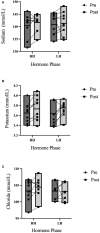Response to a Water Bolus in Long Term Oral Contraceptive Users
- PMID: 35548460
- PMCID: PMC9082411
- DOI: 10.3389/fspor.2022.857719
Response to a Water Bolus in Long Term Oral Contraceptive Users
Abstract
The purpose of our study was to determine the responses to an acute water bolus in long-term oral contraception (OCP) users. Seventeen female volunteers (27 ± 5 y, 64.1 ± 13.7 kg, 39.6 ± 5.9 kg/LBM) provided consent and enrolled in our study. All were long-term OCP users and participated in two trials, one during the active pill (High Hormone, HH) dose of their prescribed OCP and one during the sham pill (Low Hormone, LH) dose. Participants reported to the laboratory euhydrated, were fed breakfast, remained seated for 60 min and were provided a bolus of room temperature water in the amount of 12 mL/kg/LBM. Urine output over 180 min was measured. Nude body mass was measured pre- and post-trial. Urine specific gravity (USG) and urine osmolality were analyzed. Between trials, there were no differences in 3-h total urine volume (P = 0.296), 3-h USG (P = 0.225), 3-h urine osmolality (P = 0.088), or 3-h urine frequency (P = 0.367). Heart rate was not different between trials (P = 0.792) nor over time (P = 0.731). Mean arterial pressure was not different between trials (P = 0.099) nor over time (P = 0.262). Perceived thirst demonstrated a significant main effect for increasing over time regardless of trial (P < 0.001) but there was no difference between trials (P = 0.731). The urgency to void was not different between trials (P = 0.149) nor over time (P = 0.615). Plasma volume change was not different between trials (P = 0.847) (HH: -3.4 ± 5.0, LH post: -3.8 ± 4.5%) and plasma osmolality did not differ between trials (P = 0.290) nor over time (P = 0.967) (HH pre: 290 ± 4, HH post: 289 ± 4, LH pre: 291 ± 4, LH post: 291 ± 4 mosm/L). Blood glucose significantly decreased over time (P < 0.001) but there was no difference between trials (P = 0.780) (HH pre: 95.9 ± 113.9, HH post: 86.8 ± 6.5, LH pre: 95.9 ± 13.5, LH post: 84.6 ± 9.4 mmol/L). Copeptin concentration did not differ between phases of OCP use (P = 0.645) nor from pre- to post-trial (P = 0.787) Despite fluctuations in hormone concentrations, responses to a water bolus seem to be unaffected in OCP users in euhydrated, resting conditions.
Keywords: copeptin; euhydration; female sex hormones; hormonal contraception; resting conditions.
Copyright © 2022 Atkins, McDermott, Colburn and Kavouras.
Conflict of interest statement
The authors declare that the research was conducted in the absence of any commercial or financial relationships that could be construed as a potential conflict of interest.
Figures



Similar articles
-
Pulsatile luteinizing hormone patterns in long term oral contraceptive users.J Clin Endocrinol Metab. 1993 Aug;77(2):420-6. doi: 10.1210/jcem.77.2.8345046. J Clin Endocrinol Metab. 1993. PMID: 8345046
-
Heart rate variability across the menstrual cycle in young women taking oral contraceptives.Psychophysiology. 2015 Nov;52(11):1451-5. doi: 10.1111/psyp.12510. Epub 2015 Sep 2. Psychophysiology. 2015. PMID: 26332575
-
Arterial stiffness and blood pressure are similar in naturally menstruating and oral contraceptive pill-using women during the higher hormone phases.Exp Physiol. 2022 Apr;107(4):374-382. doi: 10.1113/EP090151. Epub 2022 Mar 8. Exp Physiol. 2022. PMID: 35199392
-
Do the emotional side-effects of hormonal contraceptives come from pharmacologic or psychological mechanisms?Med Hypotheses. 2004;63(2):268-73. doi: 10.1016/j.mehy.2004.02.013. Med Hypotheses. 2004. PMID: 15236788 Review.
-
Sex steroid hormones and breast cancer: is there a link with oral contraceptives and hormone replacement therapy?Med J Aust. 1992 Jan 20;156(2):124-32. Med J Aust. 1992. PMID: 1736053 Review.
References
LinkOut - more resources
Full Text Sources

